(新课标)Module 1 Wonders of the world Unit 3 Language in use (一)课件(27张ppt)
文档属性
| 名称 | (新课标)Module 1 Wonders of the world Unit 3 Language in use (一)课件(27张ppt) | 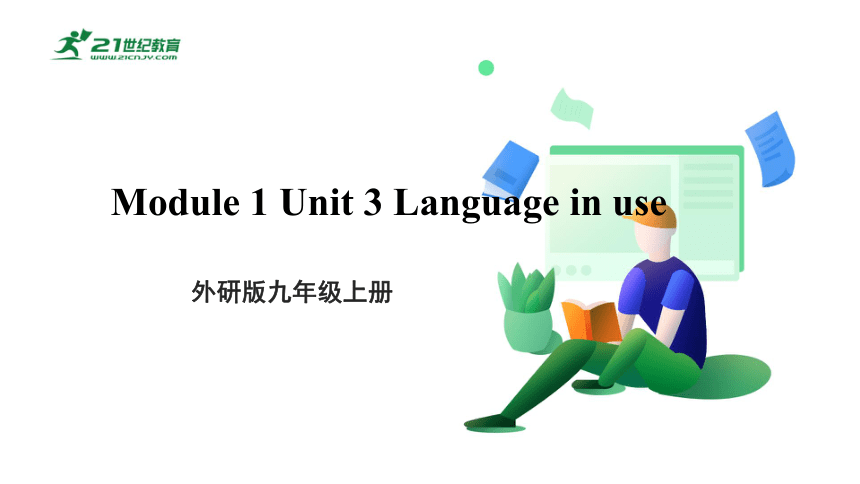 | |
| 格式 | pptx | ||
| 文件大小 | 1.2MB | ||
| 资源类型 | 试卷 | ||
| 版本资源 | 外研版 | ||
| 科目 | 英语 | ||
| 更新时间 | 2022-07-12 17:51:23 | ||
图片预览


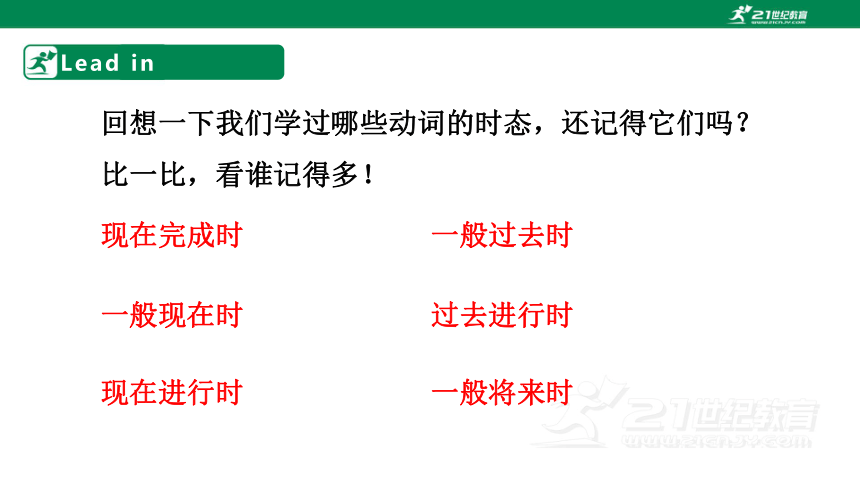
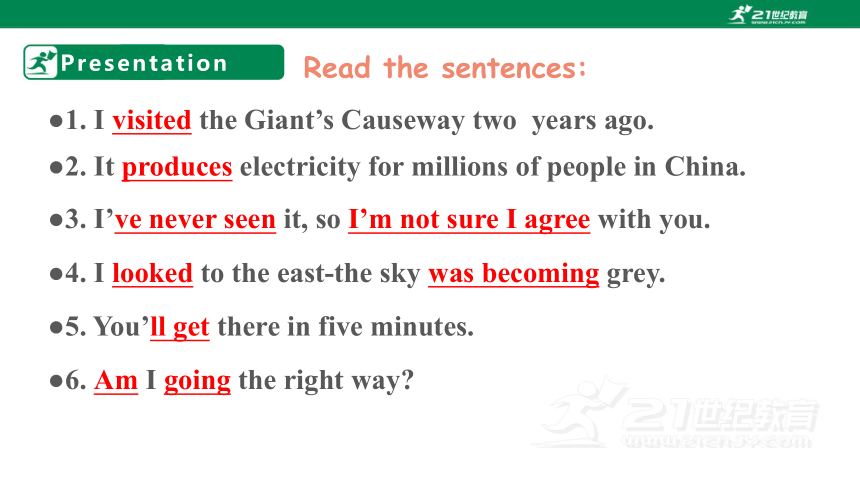
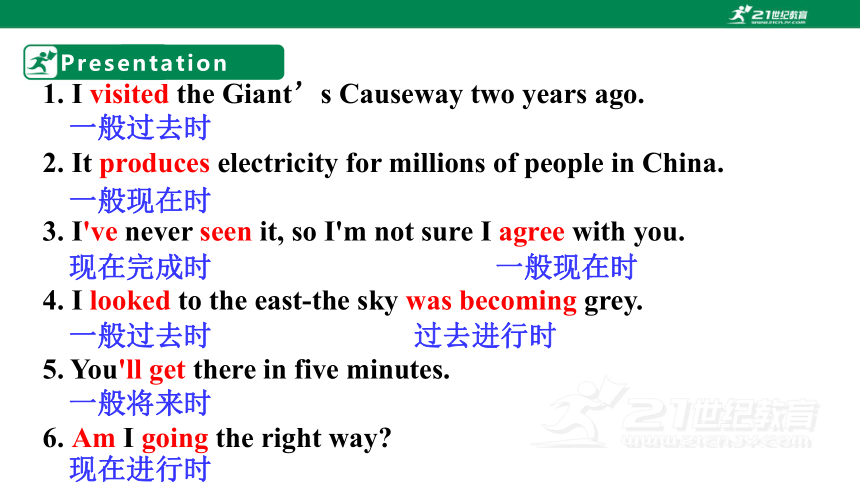
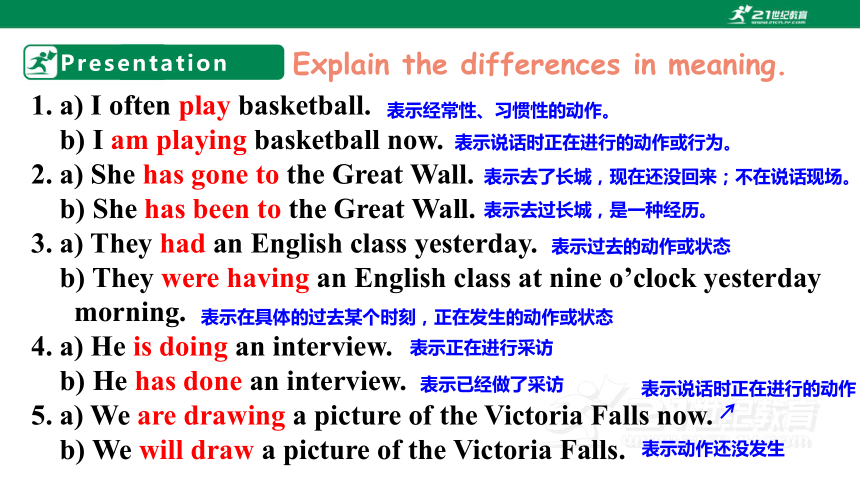
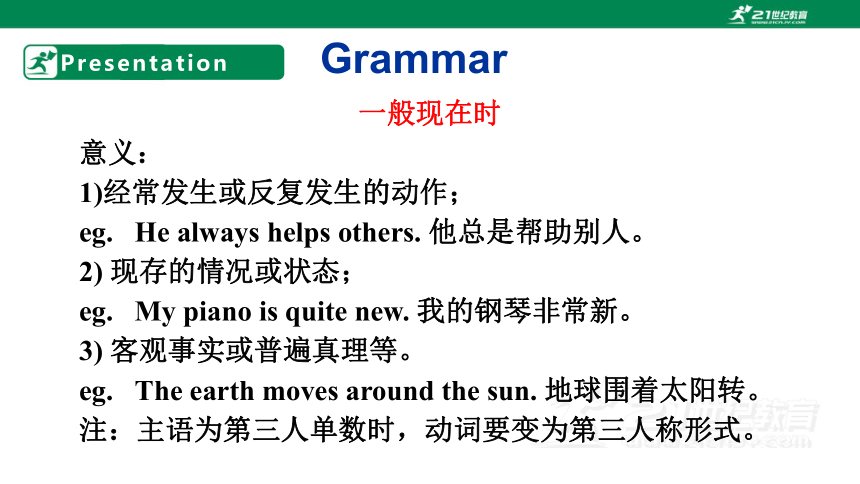
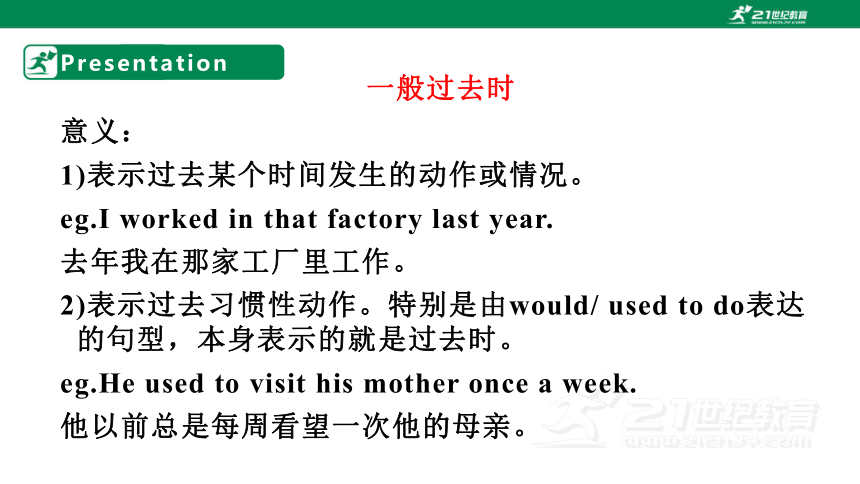
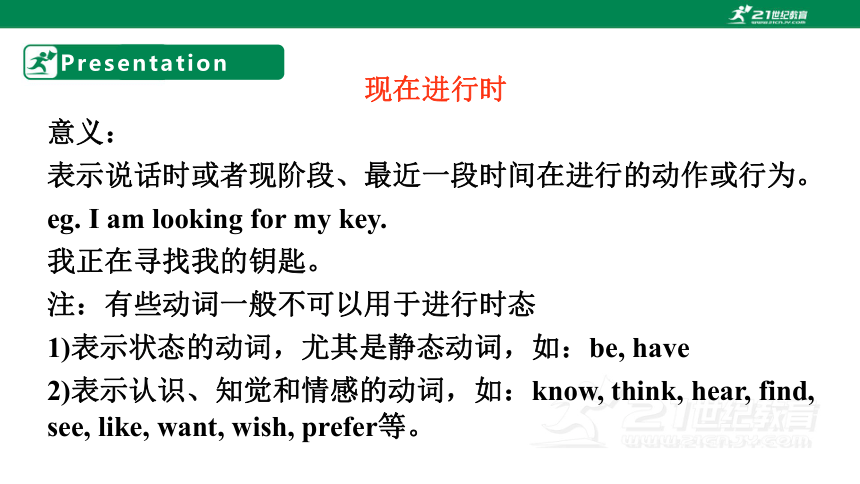
文档简介
(共27张PPT)
Module 1 Unit 3 Language in use
外研版九年级上册
Learning objectives
1.To review the key words, phrases, and sentences of M1.
2.To learn to use different tenses
Lead in
一般过去时
回想一下我们学过哪些动词的时态,还记得它们吗?比一比,看谁记得多!
现在进行时
一般将来时
一般现在时
过去进行时
现在完成时
1. I visited the Giant’s Causeway two years ago.
2. It produces electricity for millions of people in China.
3. I’ve never seen it, so I’m not sure I agree with you.
4. I looked to the east-the sky was becoming grey.
5. You’ll get there in five minutes.
6. Am I going the right way
Read the sentences:
Presentation
1. I visited the Giant’s Causeway two years ago.
2. It produces electricity for millions of people in China.
3. I've never seen it, so I'm not sure I agree with you.
4. I looked to the east-the sky was becoming grey.
5. You'll get there in five minutes.
6. Am I going the right way
一般过去时
一般现在时
现在完成时
一般现在时
一般过去时
过去进行时
一般将来时
现在进行时
Presentation
Explain the differences in meaning.
1. a) I often play basketball.
b) I am playing basketball now.
2. a) She has gone to the Great Wall.
b) She has been to the Great Wall.
3. a) They had an English class yesterday.
b) They were having an English class at nine o’clock yesterday morning.
4. a) He is doing an interview.
b) He has done an interview.
5. a) We are drawing a picture of the Victoria Falls now.
b) We will draw a picture of the Victoria Falls.
表示经常性、习惯性的动作。
表示说话时正在进行的动作或行为。
表示去了长城,现在还没回来;不在说话现场。
表示去过长城,是一种经历。
表示过去的动作或状态
表示在具体的过去某个时刻,正在发生的动作或状态
表示正在进行采访
表示已经做了采访
表示说话时正在进行的动作
表示动作还没发生
Presentation
一般现在时
意义:
1)经常发生或反复发生的动作;
eg. He always helps others. 他总是帮助别人。
2) 现存的情况或状态;
eg. My piano is quite new. 我的钢琴非常新。
3) 客观事实或普遍真理等。
eg. The earth moves around the sun. 地球围着太阳转。
注:主语为第三人单数时,动词要变为第三人称形式。
Grammar
Presentation
一般过去时
意义:
1)表示过去某个时间发生的动作或情况。
eg.I worked in that factory last year.
去年我在那家工厂里工作。
2)表示过去习惯性动作。特别是由would/ used to do表达的句型,本身表示的就是过去时。
eg.He used to visit his mother once a week.
他以前总是每周看望一次他的母亲。
Presentation
现在进行时
意义:
表示说话时或者现阶段、最近一段时间在进行的动作或行为。
eg. I am looking for my key.
我正在寻找我的钥匙。
注:有些动词一般不可以用于进行时态
1)表示状态的动词,尤其是静态动词,如:be, have
2)表示认识、知觉和情感的动词,如:know, think, hear, find, see, like, want, wish, prefer等。
Presentation
过去进行时
意义:
1)过去进行时表示过去某一时刻或过去某一阶段正在进行的动作。
eg. Mary was listening to light music 10 minutes ago.
10分钟前,玛丽正在听轻音乐。
2)如果when, while这样的时间状语引导词所引导的主从句之一是一般过去时,则另一个句子常用过去进行时。
eg. I was washing my hair when you knocked at the front door.
你敲前门时我正在洗头发。
Presentation
一般将来时
意义:
1. 计划或打算要做的动作;
2. 将要发生的动作或存在的状态。
eg.
We shall send her a glass hand-made craft as her birthday gift.我们将送给她一个玻璃的手工制品,作为给她的生日礼物。
My mother is coming to visit me next week and is staying here until May.
我妈妈下周将来看我,并会呆到5月。
Presentation
现在完成时
意义:
现在完成时表示某一动作对现在造成的影响或结果,也可表示过去发生的事一直持续到现在。
eg. John has broken his left leg.
约翰摔断了左腿。
注:
have/has been to 意为“曾经去过某地”,表示一经历;have/has gone to 意为“到某地去了”。
eg. Mr Black has been to Beijing.
布莱克先生曾经去过北京。
Presentation
1. She often _____(read) English in the evening.
2. There ________( be) a film tomorrow evening.
3. Look! The twins ____________( help) their mother do the housework.
4. They ______( take) photos near the river an hour ago.
5. We ___________( learn) English for three years already. And we can speak a little English now.
6. I first met Tom 10 years ago. He __________ (work) in a radio factory at that time.
reads
will be
are helping
have learnt
took
was working
Let's do
2. Complete the sentences with the correct form of the words in the box.
appear, finish, give, rain, talk, visit, walk
1. Listen! It __________________outside.
2. The great musician _______________a concert in Guangzhou next month.
3. Last summer, my parents __________the Terracotta Army in Xi’an.
is raining
will give
visited
Let's do
4. He _______already __________ a new book about travel.
5.Thousands of people __________along the Great Wall every year.
6. A few minutes later, a stranger ______________at the end of the street.
7. The students _______________about the journey to the Grand Canyon when the teacher came into the classroom.
finished
has
walk
appeared
were talking
Let's do
3. Complete the passage with the correct form of the words in brackets.
The sun was going down when we (1) __________ (arrive) at the ground floor of the building. I(2)_________(be) afraid of going to the top of tall buildings, so I was a little nervous as we (3) ______________(wait) for the lift. The lift (4)____________ (climb) faster and faster
arrived
was
were waiting
climbed
Let's do
until we (5) __________ (reach) the 88th floor. It(6) ________ (be) high up there, but I was not afraid when I (7) ______________(stand) at the top. The Jin Mao Tower in Shanghai, one of the tallest buildings in the world,
(8)____ (be) 420.5 metres high. It was built in 1999, and it (9) ________ (have) a fantastic view of Pudong District and the centre of Shanghai. I really like the tower and I am sure I (10)__________(visit) it again.
was standing
reached
is
is
has
will visit
Let's do
A: Have you ever visited the Great Wall
B: Yes, I have. / No, I haven’t.
A: When did you visit it / When will you visit it
B: I visited it five years ago. / Maybe I’ll visit it next year.
Now complete the table.
4. Work in pairs. Talk about the wonders of
the world you have or have not visited.
Let's do
Wonders of the world When did you visit it When will you visit it
The Great Wall
Let's do
ancient, high, long, natural, opinion, wonder
The Changjiang River is about 6,300 kilometres ___________.
2. The Terracotta Army is a famous ________
wonder in China.
3. For my homework I have to write an article about the _________ of the world.
long
ancient
wonders
5. Complete the sentences with the correct form
of the words in the box. There is one extra word.
Let's do
4. Mount Qomolangma is the _________ mountain in the world.
5. In my __________, the Great Wall is the greatest man-made wonder in the world.
highest
opinion
Let's do
一、用所给动词的适当形式填空。
1. His father ________(write) two letters to his mother every month.
2. Listen! Who__________ (sing) in the next room now
3. Tom__________ (fly) a kite this time yesterday.
4. Mr Hu ___________ (teach) us maths since 1982.
writes
is singing
was flying
has taught
Exercise
、
二. 单项选择。
1. ——Tony, ______you_________ smoking
—Yes. Drinking tea is my favourite now.
A. will; stop B. did; stop C. would; stop D. have;stop
2. —Look at the noisy kids!
—Haven’t you heard the saying “When the cat is away, the mice ____.”
A. play B. played C. are playing D. will play
3. I_______ on the computer when Jim came to
see me yesterday evening.
A. work B. worked C. was working D. am working
D
D
C
Exercise
Summary
上21世纪教育网 下精品教学资源
各时态的意义:
一般现在时:1)经常发生或反复发生的动作;2) 现存的情况或状态;3) 客观事实或普遍真理等。
一般过去时:1)表示过去某个时间发生的动作或情况。2)表示过去习惯性动作。
现在进行时:表示说话时或者现阶段、最近一段时间在进行的动作或行为。
过去进行时:1)过去进行时表示过去某一时刻或过去某一阶段正在进行的动作。2)如果when, while这样的时间状语引导词所引导的主从句之一是一般过去时,则另一个句子常用过去进行时。
一般将来时:1)计划或打算要做的动作;2) 将要发生的动作或存在的状态。
现在完成时:现在完成时表示某一动作对现在造成的影响或结果,也可表示过去发生的事一直持续到现在。
Homework
1. Review the grammar.
2. Finish the rest activities in the workbook.
谢谢
21世纪教育网(www.21cnjy.com)
中小学教育资源网站
兼职招聘:
https://www.21cnjy.com/recruitment/home/admin
Module 1 Unit 3 Language in use
外研版九年级上册
Learning objectives
1.To review the key words, phrases, and sentences of M1.
2.To learn to use different tenses
Lead in
一般过去时
回想一下我们学过哪些动词的时态,还记得它们吗?比一比,看谁记得多!
现在进行时
一般将来时
一般现在时
过去进行时
现在完成时
1. I visited the Giant’s Causeway two years ago.
2. It produces electricity for millions of people in China.
3. I’ve never seen it, so I’m not sure I agree with you.
4. I looked to the east-the sky was becoming grey.
5. You’ll get there in five minutes.
6. Am I going the right way
Read the sentences:
Presentation
1. I visited the Giant’s Causeway two years ago.
2. It produces electricity for millions of people in China.
3. I've never seen it, so I'm not sure I agree with you.
4. I looked to the east-the sky was becoming grey.
5. You'll get there in five minutes.
6. Am I going the right way
一般过去时
一般现在时
现在完成时
一般现在时
一般过去时
过去进行时
一般将来时
现在进行时
Presentation
Explain the differences in meaning.
1. a) I often play basketball.
b) I am playing basketball now.
2. a) She has gone to the Great Wall.
b) She has been to the Great Wall.
3. a) They had an English class yesterday.
b) They were having an English class at nine o’clock yesterday morning.
4. a) He is doing an interview.
b) He has done an interview.
5. a) We are drawing a picture of the Victoria Falls now.
b) We will draw a picture of the Victoria Falls.
表示经常性、习惯性的动作。
表示说话时正在进行的动作或行为。
表示去了长城,现在还没回来;不在说话现场。
表示去过长城,是一种经历。
表示过去的动作或状态
表示在具体的过去某个时刻,正在发生的动作或状态
表示正在进行采访
表示已经做了采访
表示说话时正在进行的动作
表示动作还没发生
Presentation
一般现在时
意义:
1)经常发生或反复发生的动作;
eg. He always helps others. 他总是帮助别人。
2) 现存的情况或状态;
eg. My piano is quite new. 我的钢琴非常新。
3) 客观事实或普遍真理等。
eg. The earth moves around the sun. 地球围着太阳转。
注:主语为第三人单数时,动词要变为第三人称形式。
Grammar
Presentation
一般过去时
意义:
1)表示过去某个时间发生的动作或情况。
eg.I worked in that factory last year.
去年我在那家工厂里工作。
2)表示过去习惯性动作。特别是由would/ used to do表达的句型,本身表示的就是过去时。
eg.He used to visit his mother once a week.
他以前总是每周看望一次他的母亲。
Presentation
现在进行时
意义:
表示说话时或者现阶段、最近一段时间在进行的动作或行为。
eg. I am looking for my key.
我正在寻找我的钥匙。
注:有些动词一般不可以用于进行时态
1)表示状态的动词,尤其是静态动词,如:be, have
2)表示认识、知觉和情感的动词,如:know, think, hear, find, see, like, want, wish, prefer等。
Presentation
过去进行时
意义:
1)过去进行时表示过去某一时刻或过去某一阶段正在进行的动作。
eg. Mary was listening to light music 10 minutes ago.
10分钟前,玛丽正在听轻音乐。
2)如果when, while这样的时间状语引导词所引导的主从句之一是一般过去时,则另一个句子常用过去进行时。
eg. I was washing my hair when you knocked at the front door.
你敲前门时我正在洗头发。
Presentation
一般将来时
意义:
1. 计划或打算要做的动作;
2. 将要发生的动作或存在的状态。
eg.
We shall send her a glass hand-made craft as her birthday gift.我们将送给她一个玻璃的手工制品,作为给她的生日礼物。
My mother is coming to visit me next week and is staying here until May.
我妈妈下周将来看我,并会呆到5月。
Presentation
现在完成时
意义:
现在完成时表示某一动作对现在造成的影响或结果,也可表示过去发生的事一直持续到现在。
eg. John has broken his left leg.
约翰摔断了左腿。
注:
have/has been to 意为“曾经去过某地”,表示一经历;have/has gone to 意为“到某地去了”。
eg. Mr Black has been to Beijing.
布莱克先生曾经去过北京。
Presentation
1. She often _____(read) English in the evening.
2. There ________( be) a film tomorrow evening.
3. Look! The twins ____________( help) their mother do the housework.
4. They ______( take) photos near the river an hour ago.
5. We ___________( learn) English for three years already. And we can speak a little English now.
6. I first met Tom 10 years ago. He __________ (work) in a radio factory at that time.
reads
will be
are helping
have learnt
took
was working
Let's do
2. Complete the sentences with the correct form of the words in the box.
appear, finish, give, rain, talk, visit, walk
1. Listen! It __________________outside.
2. The great musician _______________a concert in Guangzhou next month.
3. Last summer, my parents __________the Terracotta Army in Xi’an.
is raining
will give
visited
Let's do
4. He _______already __________ a new book about travel.
5.Thousands of people __________along the Great Wall every year.
6. A few minutes later, a stranger ______________at the end of the street.
7. The students _______________about the journey to the Grand Canyon when the teacher came into the classroom.
finished
has
walk
appeared
were talking
Let's do
3. Complete the passage with the correct form of the words in brackets.
The sun was going down when we (1) __________ (arrive) at the ground floor of the building. I(2)_________(be) afraid of going to the top of tall buildings, so I was a little nervous as we (3) ______________(wait) for the lift. The lift (4)____________ (climb) faster and faster
arrived
was
were waiting
climbed
Let's do
until we (5) __________ (reach) the 88th floor. It(6) ________ (be) high up there, but I was not afraid when I (7) ______________(stand) at the top. The Jin Mao Tower in Shanghai, one of the tallest buildings in the world,
(8)____ (be) 420.5 metres high. It was built in 1999, and it (9) ________ (have) a fantastic view of Pudong District and the centre of Shanghai. I really like the tower and I am sure I (10)__________(visit) it again.
was standing
reached
is
is
has
will visit
Let's do
A: Have you ever visited the Great Wall
B: Yes, I have. / No, I haven’t.
A: When did you visit it / When will you visit it
B: I visited it five years ago. / Maybe I’ll visit it next year.
Now complete the table.
4. Work in pairs. Talk about the wonders of
the world you have or have not visited.
Let's do
Wonders of the world When did you visit it When will you visit it
The Great Wall
Let's do
ancient, high, long, natural, opinion, wonder
The Changjiang River is about 6,300 kilometres ___________.
2. The Terracotta Army is a famous ________
wonder in China.
3. For my homework I have to write an article about the _________ of the world.
long
ancient
wonders
5. Complete the sentences with the correct form
of the words in the box. There is one extra word.
Let's do
4. Mount Qomolangma is the _________ mountain in the world.
5. In my __________, the Great Wall is the greatest man-made wonder in the world.
highest
opinion
Let's do
一、用所给动词的适当形式填空。
1. His father ________(write) two letters to his mother every month.
2. Listen! Who__________ (sing) in the next room now
3. Tom__________ (fly) a kite this time yesterday.
4. Mr Hu ___________ (teach) us maths since 1982.
writes
is singing
was flying
has taught
Exercise
、
二. 单项选择。
1. ——Tony, ______you_________ smoking
—Yes. Drinking tea is my favourite now.
A. will; stop B. did; stop C. would; stop D. have;stop
2. —Look at the noisy kids!
—Haven’t you heard the saying “When the cat is away, the mice ____.”
A. play B. played C. are playing D. will play
3. I_______ on the computer when Jim came to
see me yesterday evening.
A. work B. worked C. was working D. am working
D
D
C
Exercise
Summary
上21世纪教育网 下精品教学资源
各时态的意义:
一般现在时:1)经常发生或反复发生的动作;2) 现存的情况或状态;3) 客观事实或普遍真理等。
一般过去时:1)表示过去某个时间发生的动作或情况。2)表示过去习惯性动作。
现在进行时:表示说话时或者现阶段、最近一段时间在进行的动作或行为。
过去进行时:1)过去进行时表示过去某一时刻或过去某一阶段正在进行的动作。2)如果when, while这样的时间状语引导词所引导的主从句之一是一般过去时,则另一个句子常用过去进行时。
一般将来时:1)计划或打算要做的动作;2) 将要发生的动作或存在的状态。
现在完成时:现在完成时表示某一动作对现在造成的影响或结果,也可表示过去发生的事一直持续到现在。
Homework
1. Review the grammar.
2. Finish the rest activities in the workbook.
谢谢
21世纪教育网(www.21cnjy.com)
中小学教育资源网站
兼职招聘:
https://www.21cnjy.com/recruitment/home/admin
同课章节目录
- Module 1 Wonders of the world
- Unit 1 It's more than 2,000 years old.
- Unit 2 The Grand Canyon was not just big.
- Unit 3 Language in use
- Module 2 Public holidays
- Unit 1 My family always go somewhere interesting a
- Unit 2 We have celebrated the festival since the f
- Unit 3 Language in use
- Module 3 Heroes
- Unit 1 She trained hard,so she became a great play
- Unit 2There were few doctors, so he had to work ve
- Unit 3 Language in use
- Module 4 Home alone
- Unit 1 I can look after myself, although it won’t
- Unit 2 I became so bored with their orders that I
- Unit 3 Language in use
- Module 5 Museums
- Unit 1 Don't cross that rope!
- Unit 2 If you ever go to London, make sure you vis
- Unit 3 Language in use
- Module 6 Problems
- Unit 1 If I start after dinner, I'll finish it be
- Unit 2 If you tell him the truth now, you will sho
- Unit 3 Language in use
- Revision Module A
- Module 7 Great books
- Unit 1 We're still influenced by Confucius's idea
- Unit 2 It is still read and loved.
- Unit 3 Language in use
- Module 8 Sports life
- Unit 1 Daming wasn't chosen for the team last time
- Unit 2 He was invited to competitions around the w
- Unit 3 Language in use
- Module 9 Great inventions
- Unit 1 Will computers be used more than books in t
- Unit 2 Will books be replaced by the Internet?
- Unit 3 Language in use
- Module 10 Australia
- Unit 1 I have some photos that I took in Australia
- Unit 2 The game that they like most is Australian
- Unit 3 Language in use
- Module 11 Photos
- Unit 1 He's the boy who won the photo competition
- Unit 2 The photo which we liked best was taken by
- Unit 3 Language in use
- Module 12 Save our world
- Unit 1 If everyone starts to do something, the wor
- Unit 2 Repeat these three words daily: reduce, reu
- Unit 3 Language in use
- Revision Module B
